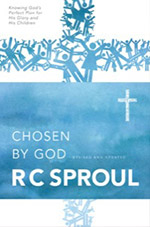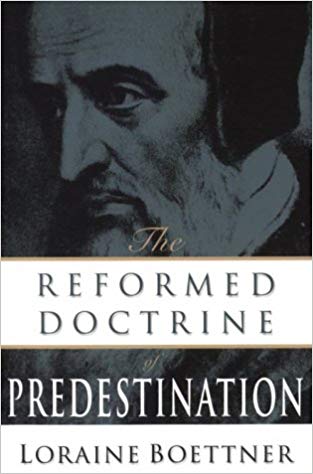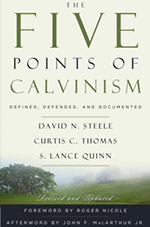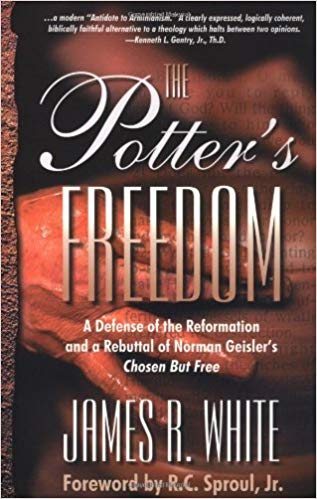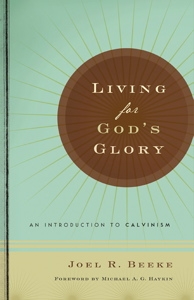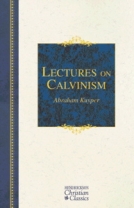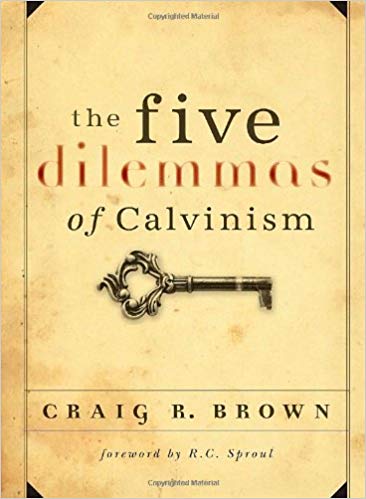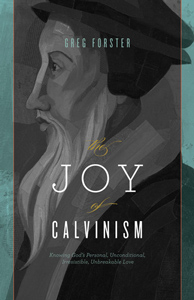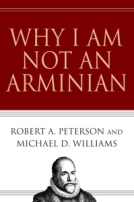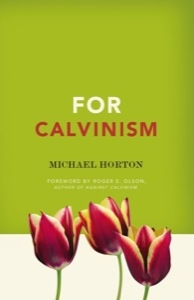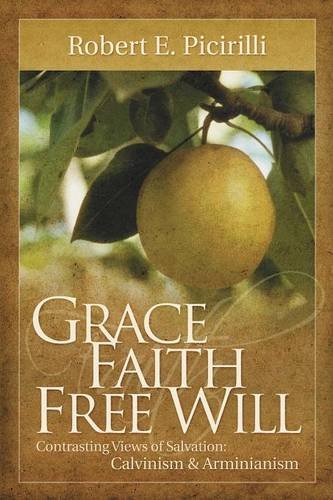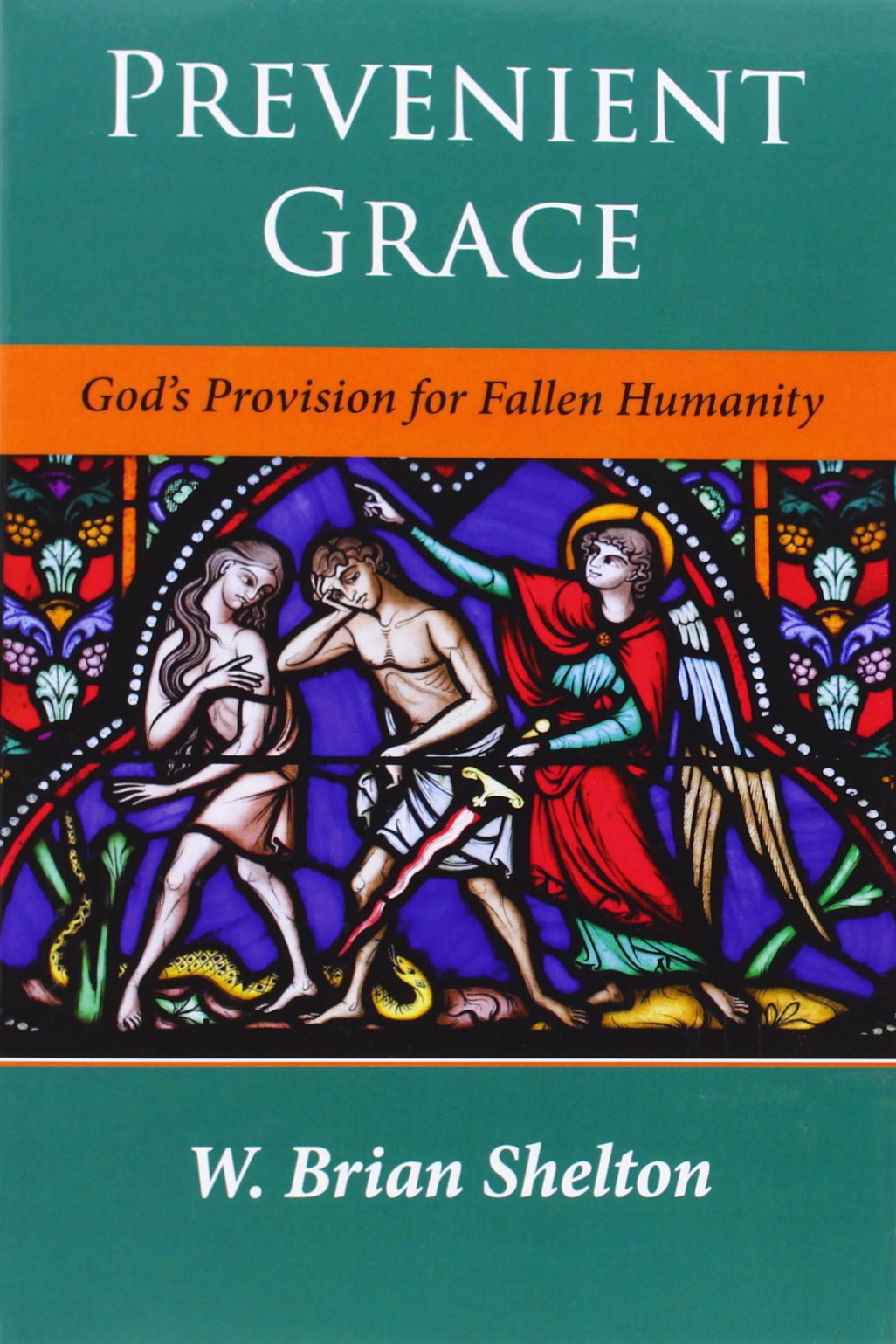A COMPARISON OF SYSTEMS
In this chapter will be presented a brief sketch of the main contrasting positions of the three rival systems of Pelagianism, Semipelagianism, and Augustinianism, or as they are denominated in their more completely developed forms, Socinianism, Arminianism, and Calvinism–together with an outline of the history of their rise and dissemination.
1. What, in general, was the state of theological thought during the first three centuries?
During the first three hundred years which elapsed after the death of the apostle John the speculative minds of the church were principally engaged in defending the truth of Christianity against unbelievers–in combating the Gnostic heresies generated by the leaven of Oriental philosophy–and in settling definitely the questions which were evolved in the controversies concerning the Persons of the Trinity. It does not appear that any definite and consistent statements were made in that age, as to the origin, nature, and consequences of human sin; nor as to the nature and effects of divine grace; nor of the nature of the redemptive work of Christ, or of the method of its application by the Holy Spirit, or of its appropriation by faith. As a general fact it may be stated, that, as a result of the great influence of Origen, the Fathers of the Greek Church pretty unanimously settled down upon a loose Semipelagianism, denying the guilt of original sin, and maintaining the ability of the sinner to predispose himself for, and to cooperate with divine grace. And this has continued the character of the Greek Anthropology to the present day. The same attributes characterized the speculations of the earliest writers of the Western Church also, but during the third and fourth centuries there appeared a marked tendency among the Latin Fathers to those more correct views afterwards triumphantly vindicated by the great Augustine. This tendency may be traced most clearly in the writings of Tertullian of Carthage, who died circum. 220, and Hilary of Poitiers (368) and Ambrose of Milan (397).
2. By what means has the Church made advances in the clear discrimination of divine truth? And in what ages, and among what branches of the Church, have the great doctrines of the trinity and Person of Christ, of sin and grace, and of redemption and the application thereof been severally defined?
The Church has always advanced toward clearer conceptions and more accurate definitions of divine truth through a process of active controversy. And it has pleased Providence that the several great departments of the system revealed in the inspired Scriptures should have been most thoroughly discussed, and clearly defined in different ages, and in the bosom of different nations.
Thus the profound questions involved in the departments of Theology proper and of Christology were investigated by men chiefly of Greek origin, and they were authoritatively defined in Synods held in the Eastern half of the General Church during the fourth and immediately following centuries. As concerns THEOLOGY the consubstantial divinity of Christ was defined in the Council of Nice, 325, and the Personality and divinity of the Holy Ghost in the first Council of Constantinople, 381; the Filioque clause being added by the Latins at the Council of Toledo, 589. As concerns Christology. The Council of Ephesus, 431, asserted the personal unity of the Theanthropos. The Council of Chalcedon, 451, asserted that the two natures remain distinct. The sixth Council of Constantinople, 680, asserted that the Lord possessed a human as well as a divine will. These decisions have been accepted by the whole Church, Greek and Roman, Lutheran and Reformed.
The questions concerning sin and grace embraced under the general head of anthropology were in the first instance most thoroughly investigated by men of Latin origin, and definite conclusions were first reached in the controversy of Augustine with Pelagius in the first half of the Fifth century.
Questions concerning redemption, and the method of its application, embraced under the grand division of soteriology, were never thoroughly investigated until the time of the Reformation and subsequently by the great theologians of Germany and Switzerland.
Many questions falling under the grand division of Ecclesiology even yet await their complete solution in the future.
3. What are the three great systems of theology which have always continued to prevail in the church?
Since the revelation given in the Scriptures embraces a complete system of truth, every single department must sustain many obvious relations, logical and otherwise, to every other as the several parts of one whole. The imperfect development, and the defective or exaggerated conception of any one doctrine, must inevitably lead to confusion and error throughout the entire system. For example, Pelagian views as to man’s estate by nature always tend to coalesce with Socinian views as to the Person and work of Christ. And Semipelagian views as to sin and grace are also irresistibly attracted by, and in turn attract Arminian views as to the divine attributes, the nature of the Atonement, and the work of the Spirit.
There are, in fact, as we might have anticipated, but two complete self-consistent systems of Christian theology possible.
1st. On the right hand, Augustinianism completed in Calvinism. 2nd. On the left hand, Pelagianism completed in Socinianism. And 3rd. Arminianism comes between these as the system of compromises and is developed Semipelagianism.
In the common usage of terms Socinianism is principally applied as the designation of those elements of the false system which relate to the Trinity of the Person of Christ; the terms Pelagianism and Semipelagianism are applied to the more extreme or the more moderate departures from the truth under the head of anthropology; and the term Arminianism is used to designate the less extreme errors concerned with the Department of soteriology.
4. When, where, and by whom were the fundamental principles of the two great antagonistic schools of theology first clearly discriminated?
The contrasted positions of the Augustinian and Pelagian systems were first taught out and defined through the controversies maintained by the eminent men whose name they bear, during the first third of the fifth century.
Augustine was bishop of Hippo in Northern Africa from A. D. 395 to A. D. 430. Pelagius, whose family name was Morgan, was a British monk. He was assisted in his controversies by his disciples Coelestius and Julian of Eclanum in Italy.
The positions maintained by Pelagius were generally condemned by the representatives of the whole Church, and have ever since been held by all denominations, except professed Socinians, to be fatal heresy. They were condemned by the two councils held at Carthage A. D. 407 and A. D. 416, by the Council held at Milevum in Numidia A. D. 416; by the popes Innocent and Zosimus, and by the Ecumenical Council held at Ephesus A. D. 431. This speedy and universal repudiation of Pelagianism proves that while the views of the early Fathers upon this class of questions were very imperfect, nevertheless the system taught by Augustine must have been in all essentials the same with the faith of the Church as a whole from the beginning.
5. State in contrast the main distinguishing positions of the Augustinian and Pelagian systems.
1st. As to ORIGINAL SIN. 1 [1 Historical Presentation of Augustinianism and Pelagianism, by G. F. Wiggers, D.D., Translated by Rev. Ralph Emerson, pp. 268-270.]
Augustinianism. By the sin of Adam, in whom all men together sinned, sin and all the other positive punishments of Adam’s sin came into the world. By it human nature has been both physically and morally corrupted. Every man brings into the world with him a nature already so corrupt, that it can do nothing but sin. The propagation of this quality of his nature is by concupiscence.
Pelagianism. By his transgression, Adam injured only himself, not his posterity. In respect to his moral nature, every man is born in precisely the same condition in which Adam was created. There is therefore no original sin.
2nd. As to FREE WILL.
Augustinianism. By Adam’s transgression the Freedom of the human Will has been entirely lost. In his present corrupt state man can will and do only evil.
Pelagianism. Man’s will is free. Every man has the power to will and to do good as well as the opposite. Hence it depends upon himself whether he be good or evil.
3rd. As to GRACE.
Augustinianism. If nevertheless man in his present state, wills and does good, it is merely the work of grace. It is an inward, secret, and wonderful operation of God upon man. It s a preceding as well as an accompanying work. By preceding grace, man attains faith, by which he comes to an insight of good, and by which power is given him to will the good. He needs cooperating grace for the performance of every individual good act. As man can do nothing without grace, so he can do nothing against it. It is irresistible. And as man by nature has no merit at all, no respect at all can be had to man’s moral disposition, in imparting grace, but God acts according to his own free will.
Pelagianism. Although by free will, which is a gift of God, man has the capacity of willing and doing good without God’s special aid, yet for the easier performance of it, God revealed the law; for the easier performance, the instruction and example of Christ aid him; and for the easier performance, even the supernatural operations of grace are imparted to him. Grace, in the most limited sense (gracious influence) is given to those’ only who deserve it by the faithful employment of their own powers. But man can resist it.
4th. As to PREDESTINATION AND REDEMPTION.
Augustinianism. From eternity, God made a free and unconditional decree to save a few 2 [2 The doctrine of Augustine does not by any means involve the conclusion that the elect are ‘ few ‘ or ‘ a small number.’] from the mass that was corrupted and subjected to damnation. To those whom he predestinated to this salvation, he gives the requisite means for the purpose. But on the rest, who do not belong to this small number of the elect, the merited ruin falls. Christ came into the world and died for the elect only.
Pelagianism. God’s decree of election and reprobation is founded on prescience. Those of whom God foresaw that they would keep his commands, he predestinated to salvation; the others to damnation. Christ’s redemption is general. But those only need his atoning death who have actually sinned. All, however, by his instruction and example, may be led to higher perfection and virtue.
6. What was the origin of the Middle or Semipelagian system?
In the meantime, while the Pelagian controversy was at its height, John Cassian, of Syrian extraction and educated in the Eastern Church, having removed to Marseilles, in France, for the purpose of advancing the interests of monkery in that region, began to give publicity to a scheme of doctrine occupying a middle position between the systems of Augustine and Pelagius. This system, whose advocates were called Massilians from the residence of their chief, and afterward Semipelagians by the Schoolmen, is in its essential principles one with that system which is now denominated Arminianism, a statement of which will be given in a subsequent part of this chapter. Faustus, bishop of Priez, in France, from A. D. 427 to A. D. 480, was one of the most distinguished and successful advocates of this doctrine, which was permanently accepted by the Eastern Church, and for a time was widely disseminated throughout the Western also, until it was condemned by the synods of Orange and Valence, A. D. 529.
7. What is the relation of Augustinianism to Calvinism and of Semipelagianism to Arminianism?
After this time Augustinianism became the recognized orthodoxy of the Western Church, and the name of no other uninspired man exerts such universal influence among Papists and Protestants alike. If any human name ought to be used to designate a system of divinely revealed truth, the phrase
Augustinianism as opposed to Pelagianism properly designates all those elements of faith which the whole world of Evangelical Christians hold in common. On the other hand Augustinianism as opposed to Semipelagianism properly designates that system commonly called Calvinism–while Cassianism would be the proper historical designation of that Middle or Semipelagian Scheme now commonly styled Arminianism.
8. How were parties divided with respect to these great systems among the Schoolmen, and how are they in the modern papal Church?
After the lapse of the dark ages, during which all active speculation slumbered, the great Thomas Aquinas, an Italian by birth, A. D. 1224, and a monk of the order of St. Dominic, Doctor Angelicus, advocated with consummate ability the Augustinian system of theology in that cumbrous and artificial manner which characterized the Schoolmen. John Duns Scotus, a native of Britain, A. D. 1265, a monk of the order of St. Francis, Doctor Subtilis, was in that age the ablest advocate of the system then styled Semipelagian. The controversies then revived were perpetuated for many ages, the Dominicans and the Thomists in general advocating unconditional election and efficacious grace, and the Franciscans and the Scotists in general advocating conditional election and the inalienable power of the human will to cooperate with or to resist divine grace. The same disputes under various party names continue to agitate the Romish Church since the Reformation, although the genius of her ritualistic system, and the predominance of the Jesuits in her councils, have secured within her bounds the almost universal prevalence of Semipelagianism.
The general Council, commenced at Trent, A. D. 1546, attempted to form a non-committal Creed that would satisfy the adherents of both systems. Accordingly the Dominicans and Franciscans have both claimed that their respective views were sanctioned by that Synod. The truth is that while the general and indefinite statements of doctrine to be found among its canons are often Augustinian in form, the more detailed and accurate explanations which follow these are uniformly Semipelagian.–Principal Cunningham’s ‘Historical Theology’ vol. 1, pp. 483-495.
The order of the Jesuits, founded by Ignatius Loyola, A. D. 1541, has always been identified with Semipelagian Theology. Lewis Molina, a Spanish Jesuit, A. D. 1588, the inventor of the distinction denoted by the term ‘Scientia Media,’ attained to such distinction as its advocate, that its adherents in the Papal Church have been for ages styled Molinists. In 1638 Jansenius, Bishop of Ypres in the Netherlands died leaving behind him his great work, Augustinus, wherein he clearly unfolded and established by copious extracts the true theological system of Augustine. This book occasioned very widespread contentions, was ferociously opposed by the Jesuits, and condemned by the Bulls of popes Innocent X. and Alexander VII., A. D. 1653 and 1656–which last were followed in 1713 by the more celebrated Bull ‘imigenitus’ of Clement XI., condemning the New Testament Commentary of Quesnel. The Augustinians in that Church were subsequently called Jansenists, and had their principal seat in Holland and Belgium and at Port Royal near Paris. They have numbered among them some very illustrious names, as Tillemont, Arnauld, Nicole Pascal, and Quesnel. These controversies between the Dominicans and Molinists, the Jansenists and Jesuits, have continued even to our own time, although at present Semipelagianism shares with Jesuitism in its almost unlimited sway in the Papal Church, which has definitely triumphed in the Vatican council, 1870.
9. What is the position of the Lutheran church with relation to these great systems?
Luther, a monk of the order of Augustine, and an earnest disciple of that father, taught a system of faith agreeing in spirit and in all essential points with that afterwards more systematically developed by Calvin. The only important point in which he differed from the common consensus of the Calvinistic Churches related to the literal physical presence of the entire person of Christ in, with, and under the elements in the Eucharist. With these opinions of Luther Melanchthon appears to have agreed at the time he published the first edition of his ‘Loci Communes.’ His opinions, however, as to the freedom of man and the sovereignty of divine grace were subsequently gradually modified. After the death of Luther, at the Leipsic Conference in 1548, he explicitly declared his agreement with the synergists, who maintain that in the regenerating act the human will cooperates with divine grace. Melanchthon, on the other hand, held a view of the relation of the sign to the grace signified thereby in the Sacraments, much more nearly conforming to opinions of the disciples of ingli and Calvin than generally prevailed in his own Church. His position on both these points gave great offense to the Old Lutherans, and occasioned protracted and bitter controversies. finally, the Old or Strict Lutheran party prevailed over their antagonists, and their views received a complete scientific statement in the ‘Formula Concordiae’ published 1580. Although this remarkable document never attained a position by the side of the Augsburg Confession and Apology as the universally recognized Confession of the Lutheran Churches, it may justly be taken as the best available witness as to what strictly Lutheran theology when developed into a complete system really is.
The Characteristics of Lutheran theology as contrasted with that of the Reformed Churches may be briefly stated under the following heads:
1st. As to THEOLOGY PROPER AND CHRISTOLOGY the only points in which it differs from Calvinism are the following:
- As to the DIVINE ATTRIBUTES OF SOVEREIGN FOREORDINATION, they hold that as far as it is concerned with the actions of moral agents it is limited to those actions which see morally good, while it sustains no determining relation to those which are bad. God foreknows all events of whatever kind; he foreordains all the actions of necessary agents, and the good actions of free agents–but nothing else.
- As to CHRISTOLOGY, they hold that in virtue of the hypostatical union the human element of Christ’s person partakes with the divine in at least some of its peculiar attributes. Thus his human soul shares in the omniscience and omnipotence of his divinity, and his body in its omnipresence, and together they have the power of giving life to the truly believing recipient of the sacrament.
2nd. As to ANTHROPOLOGY, they hold views identical with those held by the staunchest advocates of the Reformed theology–for instance the antecedent and immediate imputation of Adam’s public sin; the total moral depravity of all his descendants from birth and by nature, and their absolute inability to do aright in their own strength anything which pertains to their relation to God.
3rd. As to the Great central elements of SOTERIOLOGY, they agree with the Reformed with great exactness as to the nature and necessity of the expiatory work of Christ; as to forensic justification through the imputation to the believer of both the active and passive obedience of Christ; as to the nature and office of justifying faith; as to the sole agency of divine grace in the regeneration of the sinner, with which, in the first instance, the dead soul is unable to cooperate; as to God’s eternal and sovereign election of believers in Christ, not because of anything foreseen in them, but because of his own gracious will–and consequently as to the fact that the salvation of every soul really saved is to be attributed purely and solely to the grace of God, and not in any degree to the cooperating will or merit of the man himself.
At the same time they teach, with obvious logical inconsistency, that the grace of the gospel is in divine intention absolutely universal. Christ died equally and in the same sense for all men. He gives grace alike to all men. Those who are lost are lost because they resist the grace. Those who are saved owe their salvation simply to the grace they have in common with the lost–to the very same grace–not to a greater degree of grace nor to a less degree of sin–not to their own improvement of grace, but simply to the grace itself. According to them God sovereignly elects all those who are saved, but he does not sovereignly pass over those who are lost. He gives the same grace to all men, and the difference is determined persistent resistance of those who are lost.
The grand distinction of Lutheranism however relates to their doctrine of the EUCHARIST. They hold to the real physical presence of the Lord in the Eucharist, in, with, and under the elements, and that the grace signified and conveyed by the sacraments is necessary to salvation, and conveyed ordinarily by no other means. Hence the theology and church life of the strict Lutherans center in the sacraments. They differ from the high sacramental party in the Episcopal church chiefly in the fact that they ignore the dogma of apostolic succession, and the traditions of the early church.
10. Into what two great parties has the Protestant world always been divided?
The whole Protestant world from the time of the Reformation has been divided into two great families of churches classified severally as LUTHERAN, or those whose character was derived from Luther and Melanchthon; and as reformed or those who have received the characteristic impress of Calvin. The LUTHERAN family of churches comprises all of those Protestants of Germany, of Hungary, and the Baltic provinces of Russia, who adhere to the Augsburg confession, together with the national churches of Denmark and of Norway and Sweden, and the large denomination of the name in America. These are estimated as amounting to a population of about twenty-five million pure Lutherans, while the Evangelical Church of Prussia, which was formed of a political union of the adherents of the two confessions, embraces probably eleven-and-a-half million. Their Symbolical Books are the Augsburg Confession and Apology, the Articles of Smalcald, Luther’s Larger and Smaller Catechism, and, as received by the Stricter party, the Formula Concordiae. The CALVINISTIC or REFORMED churches embrace, in the strict usage of the term, all those Protestant Churches which derive their Theology from Geneva; and among these, because of obvious qualifying conditions, the Episcopal Churches of England, Ireland, and America form a subdivision by themselves; and the Wesleyan Methodists, who are usually classed among the Reformed because they were historically developed from that stock, are even yet more distinctly than the parent church of England removed from the normal type of the general class. In a general sense, however, this class comprises all those churches of Germany which subscribe to the Heidelburg Catechism, the churches of Switzerland, France, Holland, England, and Scotland, the Independents and Baptists of England and America, and the various branches of the Presbyterian Church in England, Ireland, and America. These embrace about eight million German Reformed in the Reformed church of Hungary; twelve million and a half Episcopalians; Presbyterians six million; Methodists, three million and a half; Baptists, four million and a half; and independents’ one million and a half;–in all about thirty-eight millions.
The principal confessions of the Reformed Church are the Gallic, Belgic, 2d Helvetic, and Scotch Confessions; the Heidelburg Catechism; the Thirty-nine Articles of the Church of England; the Canons of the Synod of Dort, and the Confession and Catechisms of the Westminster Assembly.
11. State the Origin of the Unitarian Heresy.
In the early church the Ebionites, a Jewish-Gnostic Christian sect, were the only representatives of those in modern times called Socinians. A party among them were called Elkesaites. Their ideas, with special modifications, are found expressed in the Clementine ‘Homilies,’ written about A. D. 150 in Oriental Syria. The most distinguished humanitarians in the early church were the two Theodotuses of Rome, both laymen, Artemon (t180) and Paul of Samosata, bishop of Antioch (260-270), deposed by a Council held 269. Most of these admitted the supernatural birth of Christ, but maintained that he was a mere man, honored by a special divine influence. They admitted an apotheosis or relative deification of Christ consequent upon his earthly achievements. (Dr. E. De Pressense, ‘Early Years of Christianity’ Part 3, bk. 1, chs. 3 and 5).
Cerinthus, who lived during the last of the first and the first of the second century, held that Jesus was a mere man born of Mary and Joseph, that the Christ or Logos came down upon him in the shape of a dove at his baptism when he was raised to the dignity of the son of God, and wrought miracles, etc. The Logos left the man Jesus to suffer alone at his crucifixion. The resurrection also was denied.
They were succeeded by the Arians in the fourth century. During the Middle Ages there remained no party within the church that openly denied the supreme divinity of our Lord. In modern times Unitarianism revived at the period the Reformation through the agency of Laelius Socinus of Italy. It was carried by him into Switzerland and existed there as a doctrine professed by a few conspicuous heretics from 1525 to 1560. The most prominent of its professors were the Socini, Servetus, and Ochino. It existed as an organized church at Racow in Poland, where the exiled heretics found a refuge from 1539 to 1658, when the Socinians were driven out of Poland by the Jesuits, and passing into Holland became absorbed in the Remonstrant or Armenian Churches. In 1609 Schmetz drew up from materials afforded by the teaching of Faustus Socinus, the nephew of Laelius, and of J. Crellius, the Racovian Catechism, which is the standard of Socinianism (see Ree’s translation, 1818.) After their dispersion Andrew Y. Wissowatius and others collected the most important writings of their leading theologians under the title ‘Bibliotheca Fratrum Polonorum.’ Socinianism was developed by these writers with consummate ability, and crystallized into its most perfect form, as a logical system. It is purely Unitarian in its theology– Humanitarian in its Christology, Pelagian in its Anthropology– and its Soteriology was developed in perfect logical and ethical consistency with those elements. A statement of its characteristic positions will be found below.
It reappeared again as a doctrine held by a few isolated men in England in the seventeenth century. During the eighteenth century a number of degenerate Presbyterian (churches in England lapsed into Socinianism, and towards the end of the same century a larger number of Congregational Churches in Eastern Massachusetts followed their example and these together constitute the foundation of the modern Unitarian Denomination.
‘Its last form is a modification of the old Socinianism formed under the pressure of evangelical religion on the one hand, and of rationalistic criticism on the other. Priestley, Channing, and J. Martineau are the examples of the successive phases of Modern Unitarianism. Priestley, of the old Socinian- building itself upon a sensational philosophy; Channing, of an attempt to gain a large development of the spiritual element; Martineau, of the elevation of view induced by the philosophy of Cousin, and the introduction of the idea of historical progress in religious ideas.’-‘Farrar’s Crit. Hist. of Free Thought,’ Bampton Lecture, 1862.
12. At what date and under what circumstances did modern Arminianism arise?
James Arminius, professor of theology in the university of Leyden from 1602 until his death in 1609, although a minister of the Calvinistic Church of Holland, at first secretly, and afterwards more openly, advocated that scheme of theological opinion which has ever subsequently been designated by his name. These views were rapidly diffused, and at the same time strongly opposed by the principal men in the church. His disciples, consequently, about a year after his death formed themselves into an organized party. and in that capacity presented a Remonstrance to the States of Holland and West Friesland, praying to be allowed to hold their places in the church without being subjected by the ecclesiastical courts to vexatious examinations as to their orthodoxy. From the fact that the utterance of this Remonstrance was their first combined act as a party, they were afterwards known in history as Remonstrants.
Soon after this the Remonstrants, for the sake of defining their position, presented to the authorities five Articles expressing their belief on the subject of Predestination and Grace. This is the origin of the famous ‘five Points’ in the controversy between Calvinism and Arminianism. Very soon however the controversy took a much wider range, and the Armenians were forced by logical consistency to teach radically erroneous views with respect to the nature of; sin, original sin, imputation, the nature of the Atonement, and Justification by faith. some of their later writers carried the rationalistic spirit inherent in their system to its legitimate results in a hardly qualified Plagiarism, and some were even suspected of Socinianism.
As all other means had failed to silence the innovators, the States General called together a General Synod at Dort in Holland, which held its sessions in the year 1618-1619. It consisted of pastors, elders, and theological professors from the churches of Holland, and deputies from the churches of England Scotland, Hesse, Bremen, the Palatinate and Switzerland:the promised attendance of delegates from the French churches being prevented by an interdict of their king. The foreign delegates present were nineteen Presbyterians from Reformed churches on the Continent, and one from Scotland, and four Episcopalians from the church of England headed by the bishop of Llandaff. This Synod unanimously condemned the doctrines of the Armenians, and in their Articles confirmed the common Calvinistic faith of the Reformed churches. The most distinguished Remonstrant Theologians who succeeded Arminius were Episcopius, Curcellaeus, Limborch, Le Clerc, Wetstein, and the illustrious jurisconsult Grotius.
The denomination of Methodists in Great Britain and America is the only large Protestant body in the world it an avowedly Armenian Creed. Their Arminianism, however as presented by their standard writer, Richard Watson, an incomparably more competent theologian than Wesley, is far less removed from the Calvinism of the Westminster Assembly than the system of the later Remonstrants, and should always be designated by the qualified phrase ‘ Evangelical Arminianism.’ In the hands of Watson the Anthropology and Soteriology of Arminianism are in a general sense nearly assimilated to the corresponding provinces of Lutheranism, and of the Calvinism of Baxter, and of the French School of the seventeenth century.
13. Give an outline of the main positions of the Socinian System.
THEOLOGY AND CHRISTOLOGY.
1st. Divine Unity.
- This unity inconsistent with any personal distinctions in the Godhead.
- Christ is a mere man.
- The Holy Ghost is an impersonal divine influence.
2d. Divine Attributes.
- There is no principle of vindicatory justice in God. Nothing to prevent his acceptance of sinners on the simple ground of repentance.
- Future contingent events are essentially unknowable. The foreknowledge of God does not extend to such events.
ANTHROPOLOGY.
- Man was created without positive moral character. The ‘ image of God, ‘ in which man was said to be created did not include holiness.
- Adam in eating the forbidden fruit committed actual sin, and thereby incurred the divine displeasure, but he retained nevertheless the same moral nature and tendencies with which he was created, and he transmitted these intact to his posterity.
- The guilt of Adam’s sin is not imputed.
- Man is now as able by nature to discharge all his obligations as he ever was. The circumstances under which man’s character is now formed are more unfavorable than in Adam’s case, and therefore man is weak. But God is infinitely merciful; and obligation is graded by ability. Man was created naturally mortal and would have died had he sinned or not.
SOTERIOLOGY.
The great object of Christ’s mission was to teach and to give assurance with respect to those truths concerning which the conclusions of mere human reason are problematical. This he does both by doctrine and example.
- Christ did not execute the office of priest upon earth; but only in heaven, and there in a very indefinite sense.
- The main office of Christ was prophetical. He taught a new law. Gave an example of a holy life. Taught the personality of God. And illustrated the doctrine of a future life by his own resurrection.
- His death was necessary only as a condition unavoidably prerequisite to his resurrection. It was also designed to make a moral impression upon sinners, disposing them to repentance on account of sin, and assuring them of the clemency of God. No propitiation of divine justice was necessary, nor would it be possible by means of vicarious suffering.
ESCHATOLOGY.
- In the intermediate period between death and the resurrection the soul remains unconscious.
- ‘For it is evident from the authorities cited, that they (the older Socinians), equally with others’ constantly maintain that there will be a resurrection both of the just and of the unjust, and that the latter shall be consigned to everlasting punishment, but the former admitted to everlasting life.’ – B. Wissowatius.
‘The doctrine of the proper eternity of hell torments is rejected by most Unitarians of the present day (1818) as in their opinion wholly irreconcilable with the divine goodness, and unwarranted by the Scriptures. In reference to the future fate of the wicked, some hold that after the resurrection they will be annihilated or consigned to ‘everlasting destruction’ in the literal sense of the words:but most have received the doctrine of universal restoration, which maintains that all men, however depraved their characters may have been in this life, will, by a corrective discipline, suited in the measure of its severity to the nature of each particular case, be brought ultimately to goodness and consequently to happiness.’ (–Rees’s ‘Racovian Catechism,’ pp. 367, 368.)
ECCLESIOLOGY.
- The church is simply a voluntary society. Its object mutual improvement. Its common bond similarity of sentiments and pursuits. Its rule is human reason.
- The Sacraments are simply commemorative and teaching ordinances.
14. Give an outline of the main features of the Arminian System.
DIVINE ATTRIBUTES.
- They admit that vindicatory justice is a divine attribute, but hold that it is relaxable, rather optional than essential, rather belonging to administrative policy than to necessary principle.
- They admit that God foreknows all events without exception. They invented the distinction expressed by the term Scientia Media to explain God’s certain foreknowledge of future events, the futurition of which remain undetermined by his will or any other antecedent cause.
- They deny that God’s foreordination extends to the volitions of tree agents and hold that the eternal election of men to salvation is not absolute, but conditioned upon foreseen faith and obedience.
ANTHROPOLOGY.
- Moral character can not be created but is determined only by previous self-decision.
- Both liberty and responsibility necessarily involve possession of power to the contrary.
- They usually deny the imputation of the guilt of Adam’s first sin.
- The strict Armenians deny total depravity, and admit only the moral enfeeblement of nature. Arminius and Wesley were more orthodox but less self-consistent.
- They deny that man has ability to originate holy action or to carry it on in his own unassisted strength–but affirm that every man has power to co-operate with, or to resist ‘common grace’ That which alone distinguishes the saint from the sinner is his own use or abuse of grace.
- They regard gracious influence as rather moral and suasory than as a direct and effectual exertion of the new creative energy of God.
- They maintain the liability of the saint at every stage of his earthly career to fall from grace.
SOTERIOLOGY.
- They admit that Christ made a vicarious offering of himself in place of sinful men, and yet deny that he suffered either the literal penalty of the law, or a full equivalent for it, and maintain that his sufferings were graciously accepted as a substitute for the penalty.
- They hold that not only with respect to its sufficiency and adaptation, but also in the intention of the Father in giving the Son, and of the Son in dying, Christ died in the same sense for all men alike.
- That the acceptance of Christ’s satisfaction in the place of the infliction of the penalty on sinners in person involves a relaxation of the divine law.
- That Christ’s satisfaction enables God in consistency with his character, and the interests of his general government, to offer salvation on easier terms. The gospel hence is a new law, demanding faith and evangelical obedience instead of the original demand of perfect obedience.
- Hence Christ’s work does not actually save any, but makes the salvation of all men possible—removes legal obstacles out of the way,does not secure faith but makes salvation available on the condition of faith.
- sufficient influences of the Holy Spirit, and sufficient opportunities and means of grace are granted to all men.
- It is possible for and obligatory upon all men in this life to attain to evangelical perfection-which is explained as a being perfectly sincere-a being animated by perfect love –and doing all that is required of us under the gospel dispensation.
- With respect to the heathen some have held that in some way or other the gospel is virtually, if not in form, preached to all men. Others have held that in the future world there are three conditions corresponding to the three great classes of men as they stand related to the gospel in this world – the Status Credentium ; the Status Incredulorum ; the Status ignorantium.
15. Give a brief outline of the main features of the Calvinistic System.
THEOLOGY.
- God is an absolute sovereign, infinitely wise, righteous, benevolent, and powerful, determining from eternity the certain futurition of all events of every class according to the counsel of his own will.
- Vindicatory Justice is an essential and immutable perfection of the divine nature demanding the full punishment of all sin, the exercise of which cannot be relaxed or denied by the divine will.
CHRISTOLOGY.
The Mediator is one single, eternal, divine person, at once very God, and very man. In the unity of the Theanthropic person the two natures remain pure and unmixed, and retain each its separate and incommunicable attributes distinct. The personality is that of the eternal and unchangeable Logos. The human nature is impersonal. All mediatorial actions involve the concurrent exercise of the energies of both natures according to their several properties in the unity of the single person.
ANTHROPOLOGY.
- God created man by an immediate fiat of omnipotence and in a condition of physical, intellectual, and moral faultlessness, with a positively formed moral character.
- The guilt of Adam’s public sin is by a judicial act of God immediately charged to the account of each of his descendants from the moment he begins to exist antecedently to any act of his own.
- Hence men come into existence in a condition of condemnation deprived of those influences of the Holy Spirit upon which their moral and spiritual life depends.
- Hence they come into moral agency deprived of that original righteousness which belonged to human nature as created in Adam, and with an antecedent prevailing tendency in their nature to sin which tendency in them is of the nature of sin, and worthy of punishment.
- Man’s nature since the fall retains its constitutional faculties of reason, conscience, and free-will, and hence man continues a responsible moral agent, but he is nevertheless spiritually dead, and totally averse to spiritual good, and absolutely unable to change his own heart, or adequately to discharge any of those duties which spring out of his relation to God.
SOTERIOLOGY.
- The salvation of man is absolutely of grace. God was free in consistency with the infinite perfections of his nature to save none, few, many, or all, according to his sovereign good pleasure.
- Christ acted as Mediator in pursuance of an eternal covenant formed between the Father and the Son, according to which he was put in the law-place of his own elect people as their personal substitute, and as such by his obedience and suffering he discharged all the obligations growing out of their federal relations to law-by his sufferings vicariously enduring their penal debt by his obedience vicariously discharging those covenant demands, upon which their eternal well-being was suspended–thus fulfilling the requirements of the law, satisfying the justice of God, and securing the eternal salvation of those for whom he died.
- Hence, by his death he purchased the saving influences of the Holy Spirit for all for whom he died. And the infallibly applies the redemption purchased by Christ to all for whom he intended it, in the precise time and under the precise conditions predetermined in the eternal Covenant of Grace-and he does this by the immediate and intrinsically efficacious exercise of his power, operating directly within them, and in the exercises of their renewed nature bringing them to act faith and repentance and all gracious obedience.
- Justification is a Judicial act of God, whereby imputing to us the perfect righteousness of Christ, including his active and passive obedience, he proceeds to regard and treat us accordingly, pronouncing all the penal claims of law. to be satisfied, and us to be graciously entitled to all the immunities and rewards conditioned in the original Adamic covenant upon perfect obedience.
- Although absolute moral perfection is unattainable in this life, and assurance is not of the essence of faith, it is nevertheless possible and obligatory upon each believer to seek after and attain to a full assurance of his own personal salvation, and leaving the things that are behind to strive after perfection in all things.
- Although if left to himself every believer would fall in an instant, and although most believers do experience temporary seasons of backsliding, yet God by the exercise of his grace in their hearts, in pursuance of the provisions of the eternal Covenant of Grace and of the purpose of Christ in dying, infallibly prevents even the weakest believer from final apostasy.
